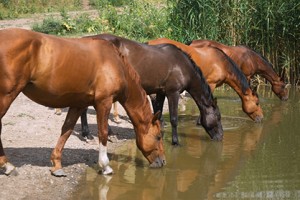Potomac Horse Fever: True or False?
Merial
Most horse owners around the country are fully aware of the threats posed by diseases such as West Nile virus (WNV), rabies and Equine Herpesvirus (EHV-1). But fewer horse owners know about Potomac Horse Fever (PHF), its inherent risks and how to determine whether or not their horse is at risk and should be vaccinated. Here’s a short true or false quiz to help separate fact from fiction.
PHF is only found near the Potomac River.
False
The name of this potentially debilitating disease is misleading. While the initial PHF outbreak in 1979 occurred near the Potomac River in Maryland,1 since then the disease has been identified in 43 states, three Canadian provinces, parts of South America, the Netherlands and France.2 Horses grazing on a pasture near the Shasta River in the 1940s showed similar clinical signs, resulting in some referring to the disease as Shasta River crud.3
PHF is caused by bites from various insects.
False
Unlike other insect-borne diseases such as WNV and Eastern Equine Encephalitis (EEE), PHF is not caused by the insect actually biting a horse, but by the horse ingesting infected aquatic insects such as damselflies, caddis flies and mayflies,4 which are commonly found in areas near creeks and rivers. This can happen while horses graze in proximity to those creeks and rivers, or when they ingest dead aquatic insects in their water buckets or hay.5
The clinical signs of PHF can include fever, decreased intestinal sounds and diarrhea.6
True
PHF can be difficult to diagnose as its clinical signs are subtle and mimic other diseases, in particular salmonellosis.5 Fevers can range from 102 – 107°F at the disease’s onset. Within two weeks of infection, the fever may be accompanied by clinical signs of colic, mild to severe diarrhea, absent appetite and depression. As the disease progresses, some horses suffer from toxemia and dehydration.6
One of the most devastating effects of PHF is the possible development of laminitis.
True
Frequently, horses develop laminitis several days after the diarrhea starts. Approximately 40 percent of horses diagnosed with PHF have subsequently developed laminitis.6
Horse owners can take measures to reduce the populations of insects that can be infected with the disease.
True
Good farm management practices include keeping your horse’s food covered, restricting grazing near creeks or other bodies of water during the peak season for PHF (spring, summer and early fall in temperate climates) and using repellents to decrease fly and other insect problems in your barn.5
Veterinarians are the best resource for determining whether or not to vaccinate a horse to help protect against PHF.
True
While not considered a core vaccination by the American Association of Equine Practitioners, Potomac Horse Fever is a disease that should be considered as a risk-based vaccination.1 Your veterinarian can help you evaluate whether or not PHF poses a significant risk and make a recommendation.
Vaccines such as Merial’s POTOMAVAC™ have been proven to be effective in helping prevent PHF.7 The vaccine is safe for horses as young as 3 months of age.8
Horse owners can help protect their horses against diseases by staying informed about potential disease threats at home and while traveling. Outbreak Alert, a free program created by Merial, tracks confirmed cases of PHF, influenza, WNV, rabies, EEE, Western Equine Encephalitis and EHV-1 around the country. Horse owners and veterinarians can check www.outbreak-alert.com to view a map of reported cases and/or sign up to receive free notification emails or texts when diseases are confirmed in their geographic area.
™POTOMAVAC is a trademark of Merial Limited. ©2014 Merial Limited, Duluth, GA. All rights reserved. EQUIBGN1406 (06/14)
1American Association of Equine Practitioners. Risk-Based Vaccination Guidelines. Potomac Horse Fever. Available at: http://www.aaep.org/info/potomac-horse-fever. Accessed June 24, 2014.
2Madigan JE and Pusterla N. Life cycle of Potomac horse fever – implications for diagnosis, treatment and control: a review. AAEP Proceedings. 2005;51:158-162.
3Kentucky Equine Research, Inc. Potomac Horse Fever. Available at: http://www.ker.com/library/EquineReview/2002/HealthLine/HL10.pdf. Accessed July 9, 2014.
4Wilson JH, Pusterla N, et al. Incrimination of mayflies as a vector of Potomac horse fever in an outbreak in Minnesota. AAEP Proceedings. 2006;52:324-328.
5Lenher E. Potomac Horse Fever. Available at: http://www.aaep.org/info/horse-health?publication=742. Accessed June 24, 2014.
6Kahn DM. Merck Veterinary Manual. 10th ed. 2010:558-559.
7Merial trial ER 8-88-2.
8POTOMAVAC product labels.











